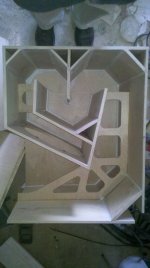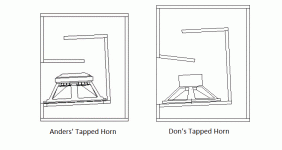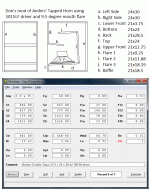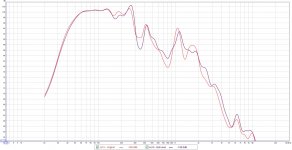The SP4000 was the first SpeakerPower amp designed and manufactured by SpeakerPower, they make all the circuit boards.It quickly becomes a very expensive enterprise to put together an amplifier that is a true voltage source. Either very large transformers or very robust switching systems, both limited to what can be drawn off of the wall outlets.
It is not an engineering impossibility.
As for the Speaker Power amplifier.
About 3 years ago I did an exhaustive study on available plate amplifiers for a client. At least then Speaker Power was using ICE modules. They were supposed to be changing over to Pascal modules. I don't know that for a fact by the way.
When the SP1-4000 was loaded at two ohms, (one BC18SW115-4 speaker and a 4 ohm resistive load) the speaker output level only dropped by 1 dB compared to the 4 ohm level.
It is very 2 ohm capable, I have used it driving 4 Lab 12 in parallel, a nominal 1.5 ohm load that goes well below the nominal rating at Fb.
It current limits with that type of load to keep from blowing the 20 amp breaker. Brian Oppegard (president of Speaker Power) had mentioned a 240 volt version of the amp which would have more output was in the works several months ago, I have not checked the site recently to see what's up.
I posted a review of the SpeakerPower Torpedo SP1-4000 Plate Amp here:
SpeakerPower Torpedo SP1-4000 Plate Amp Review
Art
that anecdotal information confirms my suspicion............... I have used it driving 4 Lab 12 in parallel, a nominal 1.5 ohm load that goes well below the nominal rating at Fb.
It current limits with that type of load to keep from blowing the 20 amp breaker.............
Finally got some time to finish up my 2nd SS15... but this time, I built one with corner fillers in the "critical" areas and a bit more extended bracing. I'll tell you what, this one was FAR more difficult to assemble than the original! Maybe I just suck at putting in corner fillers... but some things didn't square up very well and was a real nightmare. Regardless, I got it done, just took a lot more clamping, screwing, pulling, etc. to make it work right. I think my issue was using screws to secure the fillers, or perhaps I didn't get a good 45* angle cut on them... who knows.
Anywho, attached is a pic. I'll be doing a direct comparison as soon as this weekend using REW (computer to Firepod interface to Dayton calibrated mic | high end sound card to xti1002 to subs), my multimeter, my yard, measuring tape, and a good beer. I look forward to the comparison. Whichever one "wins" will get a twin built soon.
Anywho, attached is a pic. I'll be doing a direct comparison as soon as this weekend using REW (computer to Firepod interface to Dayton calibrated mic | high end sound card to xti1002 to subs), my multimeter, my yard, measuring tape, and a good beer. I look forward to the comparison. Whichever one "wins" will get a twin built soon.
Attachments
I tried to beat Jim's last cabinet, and failed. I did come up with a modification of Anders cabinet scaled up to match the size of Jim's cabinet. It's max
output is down 3dB from Jim's but it goes 5Hz lower.
If you want 40Hz in a single box, it may be your best choice.
Post 158 of this thread.
Any more information on angles and distances for the inner folds to turn this sim into a buildable version? Thanks.
Attachments
Set everything up yesterday and was ready to measure, but then a storm hit hard and heavy and we had to rush to put everything away... though it never did rain, better safe than sorry. Plus, the winds were strong enough to skew measurements. Luckily, today was wonderful.
I used REW (roomEQwizard) to compare between the two. I set my calibrated mic ~1m away (39 3/8"), used a rat-shack meter on slow/C weighted and tuned in 2.83v @ 60hz. Then, ran REW and calibrated the graph to the output of 100db @ 60hz. Here are the results. All this done on my lawn... I have about an acre of property out of city limits, so it was pretty noise free.
I can say that the extra corner fills and bracing was, as jbell predicted, was definitely not necessary and wouldn't benefit. I'll let you read the graphs to see the difference. From my experience, it was a real pain to do the extra corner fills. Sad to see the extra work put into it not pay off, but happy to build my 3rd and final version to the original, much easier to assemble version of this great design.
I used REW (roomEQwizard) to compare between the two. I set my calibrated mic ~1m away (39 3/8"), used a rat-shack meter on slow/C weighted and tuned in 2.83v @ 60hz. Then, ran REW and calibrated the graph to the output of 100db @ 60hz. Here are the results. All this done on my lawn... I have about an acre of property out of city limits, so it was pretty noise free.
I can say that the extra corner fills and bracing was, as jbell predicted, was definitely not necessary and wouldn't benefit. I'll let you read the graphs to see the difference. From my experience, it was a real pain to do the extra corner fills. Sad to see the extra work put into it not pay off, but happy to build my 3rd and final version to the original, much easier to assemble version of this great design.
Attachments
The corner fills and bracing are to keep the panels stiff. Maybe not a problem in a cabinet that takes 500-600w RMS. but in one that takes a few KW...I'd say it becomes necessary not optional.
Ahh, yes -- you are correct. I've stated several times that everything all 'falls apart' (meaning power compression, out of xmax, cabinet at limit of what it can take, etc..) all at about the same time on the ss15 -- I call that good engineering..... or maybe just getting darn lucky...
This is designed as a 500 watt class sub, using cheap eminence drivers, that can be knocked together in an afternoon, that weigh a fraction of a kilowatt class commercial sub. Where I hang cabinets... My back likes me better.
It also just happens to put a smile on my face when I crank up a pair...
BTW, peavey IPR's with dsp... and using the integrated maxxbass for HighPass is interesting. (hint)
Last edited:
ORLY, do tell more... I'll be running IPR amps when the time comesBTW, peavey IPR's with dsp... and using the integrated maxxbass for HighPass is interesting. (hint)

does the SS15 like being ran via a compressor? people are telling me i need a compressor to get the most out of my subs.
ive always thought that a more dynamic signal (ie: biggest difference between hi and low amplitude signal) was better. rather than compressing it and losing the dynamic range.
if im wrong, please learn me. otherwise, imo, i cant see why i would "need" compression to make them sound "good" coz they already sound great to me.
ive always thought that a more dynamic signal (ie: biggest difference between hi and low amplitude signal) was better. rather than compressing it and losing the dynamic range.
if im wrong, please learn me. otherwise, imo, i cant see why i would "need" compression to make them sound "good" coz they already sound great to me.
A compressor can be useful in certain situations.
If over-used the increased average levels will just overheat your speakers.
Fortunately for you as you have found out with your 4 X SS15 cabs the difficulty is getting the mid tops to keep up rather than the bass!
Some compressors can be used as a limiter just to knock off any transient peaks that would cause clipping - Digital crossovers usually have this function built in. This can gain you a few DB of volume.
I have used a compressor in the past with moronic DJ's who seem intent on blowing up the PA - I found an old school Behringer MDX 2000 - 2100 works well and sounds good. You can set up a gentle compression ratio and a clip limit - The clip limit on these compressors then adjusts the compression threshold downwards when the rig is overdriven. This is a very useful function especially for those all night gigs when you dont want to be tied to the rig every minute. I also have a Drawmer MX30 compressor on which the clip limiter is very harsh in comparison with the MDX 2100.
These days I usually use compressors to manage dynamic peaks on individual channels of a live mix, to fatten up vocals and limit drum transients.
If over-used the increased average levels will just overheat your speakers.
Fortunately for you as you have found out with your 4 X SS15 cabs the difficulty is getting the mid tops to keep up rather than the bass!
Some compressors can be used as a limiter just to knock off any transient peaks that would cause clipping - Digital crossovers usually have this function built in. This can gain you a few DB of volume.
I have used a compressor in the past with moronic DJ's who seem intent on blowing up the PA - I found an old school Behringer MDX 2000 - 2100 works well and sounds good. You can set up a gentle compression ratio and a clip limit - The clip limit on these compressors then adjusts the compression threshold downwards when the rig is overdriven. This is a very useful function especially for those all night gigs when you dont want to be tied to the rig every minute. I also have a Drawmer MX30 compressor on which the clip limiter is very harsh in comparison with the MDX 2100.
These days I usually use compressors to manage dynamic peaks on individual channels of a live mix, to fatten up vocals and limit drum transients.
Complementary subs.
I have rounded up two 3015lf's and am making a pair of SS15's. I was planing on constructing four but due to a amp upgrade I now have 850watt X4 to throw at them, should I just use the definimax or B&C drivers in the next boxes or is there another design that would be better suited to more power that could work with the SS15's.
I have rounded up two 3015lf's and am making a pair of SS15's. I was planing on constructing four but due to a amp upgrade I now have 850watt X4 to throw at them, should I just use the definimax or B&C drivers in the next boxes or is there another design that would be better suited to more power that could work with the SS15's.
I have rounded up two 3015lf's and am making a pair of SS15's. I was planing on constructing four but due to a amp upgrade I now have 850watt X4 to throw at them, should I just use the definimax or B&C drivers in the next boxes or is there another design that would be better suited to more power that could work with the SS15's.
4015lf is a very respectable driver and works great in the ss15.
A pair of lightweight 3015lf's and a pair of heavier 4015lf SS15's would be a nice quad stack.
Most of the interesting things that happen with subs happens below 500 watts in my opinion, as that's the tipping point where losses really start mounting. I don't try to make any of my designs really work at the multi-kilowatt levels.
- Home
- Loudspeakers
- Subwoofers
- Single sheet TH challenge



